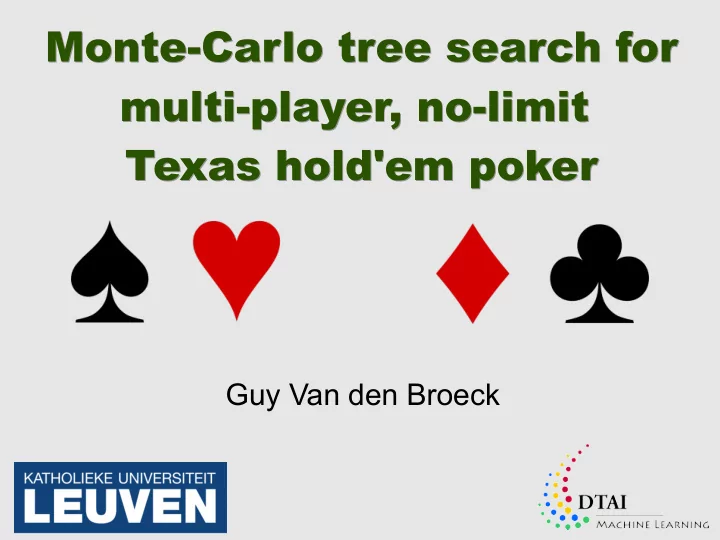

MCTS for games with uncertainty? Expected reward distributions (ERD) Sample selection using ERD Backpropagation of ERD [VandenBroeck09]
Expected reward distribution MiniMax Estimating 10 samples 100 samples ∞ samples Variance
Expected reward distribution MiniMax Estimating 10 samples 100 samples ∞ samples Variance
Expected reward distribution MiniMax Estimating 10 samples 100 samples ∞ samples Variance
Expected reward distribution MiniMax Estimating 10 samples 100 samples ∞ samples Variance
Expected reward distribution MiniMax Estimating 10 samples 100 samples ∞ samples Variance Sampling
Expected reward distribution MiniMax ExpectiMax/MixiMax Estimating 10 samples 100 samples ∞ samples Variance Sampling
Expected reward distribution MiniMax ExpectiMax/MixiMax Estimating 10 samples 100 samples ∞ samples Variance Sampling
Expected reward distribution MiniMax ExpectiMax/MixiMax Estimating 10 samples 100 samples ∞ samples Variance Sampling
Expected reward distribution MiniMax ExpectiMax/MixiMax Estimating 10 samples 100 samples ∞ samples Variance Sampling
Expected reward distribution MiniMax ExpectiMax/MixiMax Estimating 10 samples 100 samples ∞ samples Variance Sampling Uncertainty + Sampling
Expected reward distribution MiniMax ExpectiMax/MixiMax ExpectiMax/MixiMax Estimating / T(P) 10 samples 100 samples ∞ samples Variance Sampling Uncertainty + Sampling
Expected reward distribution MiniMax ExpectiMax/MixiMax ExpectiMax/MixiMax Estimating / T(P) 10 samples 100 samples ∞ samples Variance Sampling Uncertainty + Sampling
Expected reward distribution MiniMax ExpectiMax/MixiMax ExpectiMax/MixiMax Estimating / T(P) 10 samples 100 samples ∞ samples Variance Sampling Uncertainty + Sampling
Expected reward distribution MiniMax ExpectiMax/MixiMax ExpectiMax/MixiMax Estimating / T(P) 10 samples 100 samples ∞ samples Variance Sampling Uncertainty + Sampling
Expected reward distribution MiniMax ExpectiMax/MixiMax ExpectiMax/MixiMax Estimating / T(P) 10 samples 100 samples ∞ samples Variance Sampling Uncertainty + Sampling Sampling
Expected reward distribution MiniMax ExpectiMax/MixiMax ExpectiMax/MixiMax Estimating / T(P) 10 samples 100 samples ∞ samples Variance Sampling Uncertainty + Sampling Sampling
ERD selection strategy Objective? Find maximum expected reward Sample more in subtrees with (1) High expected reward (2) Uncertain estimate UCT does (1) but not really (2) CrazyStone does (1) and (2) for deterministic games (Go) UCT+ selection : (1) (2)
ERD selection strategy Objective? Find maximum expected reward Sample more in subtrees with (1) High expected reward (2) Uncertain estimate UCT does (1) but not really (2) CrazyStone does (1) and (2) for deterministic games (Go) UCT+ selection : “Expected value under perfect play”
ERD selection strategy Objective? Find maximum expected reward Sample more in subtrees with (1) High expected reward (2) Uncertain estimate UCT does (1) but not really (2) CrazyStone does (1) and (2) for deterministic games (Go) UCT+ selection : “Measure of uncertainty due to sampling”
ERD max-distribution backpropagation max A B … … 3 4
ERD max-distribution backpropagation sample-weighted max 3.5 A B … … 3 4
ERD max-distribution backpropagation sample-weighted max 3.5 max A B 4 … … 3 4
ERD max-distribution backpropagation sample-weighted max 3.5 max A B 4 … … “When the game reaches P, we'll have more time to find the real “ 3 4
ERD max-distribution backpropagation sample-weighted max 3.5 max A B 4 max-distribution … … 4.5 3 4
ERD max-distribution backpropagation P(B<4) = 0.5 P(B>4) = 0.5 P(A<4) = 0.8 P(A>4) = 0.2 max A<4 A>4 B<4 0.8*0.5 0.2*0.5 B>4 0.8*0.5 0.2*0.5 A B P(max(A,B)>4) = 0.6 > 0.5 … … 4.5 3 4
Experiments 2*MCTS 2*MCTS Max-distribution UCT+ (stddev) Sample-weighted UCT
Outline Overview approach The Poker game tree Opponent model Monte-Carlo tree search Research challenges Search Uncertainty in MCTS Continuous action spaces Opponent model Online learning Concept drift Conclusion
Dealing with continuous actions Sample discrete actions relative Progressive betsize unpruning [Chaslot08] (ignores smoothness of EV function) ... Tree learning search (work in progress)
Tree learning search Based on regression tree induction from data streams training examples arrive quickly nodes split when significant reduction in stddev training examples are immediately forgotten Edges in TLS tree are not actions, but sets of actions , e.g., (raise in [2,40]), (fold or call) MCTS provides a stream of (action,EV) examples Split action sets to reduce stddev of EV (when significant)
Tree learning search max Bet in [0,10] {Fold, Call} max ? ?
Tree learning search max Bet in [0,10] {Fold, Call} max ? ?
Tree learning search max Bet in [0,10] {Fold, Call} max ? ? Optimal split at 4
Tree learning search max Bet in [0,10] {Fold, Call} max Bet in Bet in [4,10] [0,4] max max ? ? ? ?
Tree learning search one action of P1 one action of P2
Selection Phase P1 Sample 2.4 Each node has EV estimate, which generalizes over actions
Expansion P1 P2 Selected Node
Expansion P1 P2 Expanded node P3 Represents any action of P3
Backpropagation New sample; Split becomes significant
Backpropagation New sample; Split becomes significant
Outline Overview approach The Poker game tree Opponent model Monte-Carlo tree search Research challenges Search Uncertainty in MCTS Continuous action spaces Opponent model Online learning Concept drift Conclusion
Outline Overview approach The Poker game tree Opponent model Monte-Carlo tree search Research challenges Search Uncertainty in MCTS Continuous action spaces Opponent model Online learning Concept drift Conclusion
Online learning of opponent model Start from (safe) model of general opponent Exploit weaknesses of specific opponent Start to learn model of specific opponent (exploration of opponent behavior)
Recommend
More recommend